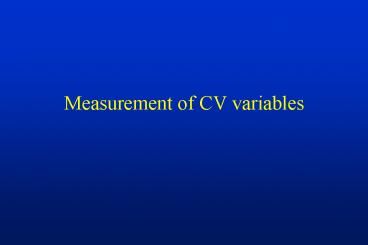Measurement of CV variables - PowerPoint PPT Presentation
1 / 23
Title:
Measurement of CV variables
Description:
Vasomotion, temperature changes, autoregulation, mean BP ... Auscultation (by ear or automatically by microphone) Oscillometry. Volume clamp. Tonometry ... – PowerPoint PPT presentation
Number of Views:64
Avg rating:3.0/5.0
Title: Measurement of CV variables
1
Measurement of CV variables
2
- In vitro
- Total control of confounding variables
- Vasomotion, temperature changes, autoregulation,
mean BP - Most accurate because vessel examined directly
- Best for detailed information about mechanical
properties of vessel material - In vivo (invasive)
- Realistic clinical information
- Limited by technical problems
- Measurement errors, transitory changes in diam.
BP etc - In vivo (non-invasive)
- Further technical problems
- Especially pressure
3
Measurement of blood pressure
- Invasive
- Pressure catheter and transducer
- Non invasive
- Sphygmomanometry
- Auscultation (by ear or automatically by
microphone) - Oscillometry
- Volume clamp
- Tonometry
4
Advantages/ drawbacks
- Invasive
- Accurate reproduction of central pressure
waveforms - Risk of thrombosis and arrhythmias
- Non-invasive
- Quick, cheap, widely used
- Lack of central pressure measurement
- Requires skilled and experienced operators
5
Sphygmomanometry
Manometer (mercury or capsule type)
d
Pulse detector (stethoscope or microphone)
d 20
www.fmshk.com.hk/sahk/lecture_noninvasive.pp
6
Sphygmomanometry
- 1896 Blood pressure cuff (Riva Rocci)
- 1905 First report of audible detection of heart
sounds used with cuff (Korotkov) - 1968 Microphone used for automatic pressure
measurement (Stegall)
7
Sphygmomanometry
Capsule manometer Replacing mercury spymomanometer
Mercury sphygmomanometer
8
Korotkov Soundscaused by vibrational collapse of
the arterial wall??
- Korotkoff V is the commonly recommended measuring
point except in pregnant patients because - It is associated with less inter-observer
variations - It is easier to detect by most observers
Systolic
Cuff pressure
Diastolic
www.fmshk.com.hk/sahk/lecture_noninvasive.pp
9
Errors
- Korotkoff sounds compared to invasive blood
pressure measurement - Korotkoff IV is on average 8mm Hg above the
invasively measured diastolic blood pressure - Korotkoff V is on average 2mm Hg above the
invasively measured diastolic blood pressure
10
Oscillometry
- Cuff round the arm
- Pressurise cuff (gt systolic)
- Allow pressure to drop slowly to zero
- Measure pressure in the cuff during deflation
11
Oscillometry set up
Micro- processor
Display
Air pump
Pressure transducer
Bleed valve
12
Principle of oscillometry
Filtered signal Of cuff pressure
Variation of cuff pressure as cuff is deflated
13
- Limitations
- Inaccurate / unreliable in shock patients
- Inaccurate / unreliable in patients with
arrhythmias - The algorithm of measurement assumes a regular
pulse, so the reading is unreliable in patients
with irregular pulse - Advantages
- No skill required
- No subjective errors
14
Volume clamp
Infra red emitter
To pump
Detected signal
Pressure
Diameter
Finger
Air
Change cuff pressure
Air
Artery
Measure cuff pressure
Detector
15
Applanation tonometry
Detects pressure of arterial pulsations through
the skin
16
Problem
- Aortic and peripheral pressures are different.
- The heart doesnt care what the pressure is in
the radial artery. - It only sees aortic pressure.
- Aortic pressure is difficult (impossible?) to
measure non-invasively - Can we reconstruct the aortic waveform from the
radial?
Aortic
Radial
120
Systolic
100
Mean
Diastolic
80
17
Yes we can. At least in principle
- Record radial waveform with tonometry
- Apply inverse transfer function
- Reconstruct aortic waveform
- What is an inverse transfer function?
- How do we reconstruct the waveform?
18
Fourier analysis
19
aortic pressure
radial artery pressure
Pa(t) pa0 pa1Cos(?t - ?a1) pa2Cos(?t -
?a2) pa3Cos(?t - ?a3) ...
Pb(t) pr0 pr1Cos(?t - ?r1) pr2Cos(?t - ?r
2) pr3Cos(?t - ?r 3) ...
For each harmonic (n) Transfer function phase
?an - ?rn Transfer function amplitude pan / prn
20
Amplification of the pulse
21
How to derive the central pressure from
peripheral measurements
- Compare Fourier series of typical aortic
pressure waves with Fourier series of the radial
pressure computed from tonometric measurements. - Calculate the amplitude ratio and phase
difference for each harmonic - Apply this ratio and phase difference to each
harmonic of the measured radial wave and
reconstruct aortic wave that would when
transmitted down the arm, producing the measured
radial wave
22
Question
- How well does the typical transfer function apply
to people of different ages and disease states
Answer
- Surprisingly well considering the changes that
occur in the arterial system with age and
vascular disease - However, most believe that more work is needed to
validate the method
23
Pressure transducers(for invasive measurement)
Diaphragm manometer
To pressure to be measured, (via an intra
arterial cannula)
Fluid filled chamber
Stiff diaphragm Measure its movement electronicall
y
- Advantages
- Cheap, disposable
- easy to use
- Accurate mean pressure
- Disadvantages
- Clotting in cannula, air bubbles
- Therefore errors in pulse pressure
24
Pressure transducers(for invasive measurement -
2)
- Advantages
- High accuracy
- Especially in very small vessels
- Disadvantages
- No calibration possible when in position
- Expensive
- Fragile
25
Pressure comparison of methods































